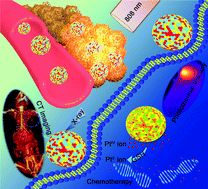Simple construction of Cu2−xS:Pt nanoparticles as nanotheranostic agent for imaging-guided chemo-photothermal synergistic therapy of cancer†
Abstract
Synergistic therapy has attracted intense attention in medical treatment because it can make up for the disadvantages of single therapy and greatly improve the efficacy of cancer treatment. However, it remains a challenge to build a simple system to achieve synergistic therapy. In this study, X-ray computed tomography (CT) imaging-guided chemo-photothermal synergistic therapy can be easily achieved by simple construction of Cu2−xS:Pt(0.3)/PVP nanoparticles (NPs). Cu2−xS:Pt(0.3)/PVP NPs can passively accumulate within the tumor sites, thus ensuring that many Cu2−xS:Pt(0.3)/PVP NPs are brought into the tumor cells, which can be confirmed by the results of cellular uptake, imaging, and nanoparticle biodistribution. It can be verified that the platinum ions can be released from Cu2−xS:Pt(0.3)/PVP NPs under 808 nm laser irradiation. Simultaneously, Pt(IV) ions are reduced to Pt(II) ions by excess glutathione and then, they exhibit chemo-anticancer activities. In addition, Cu2−xS:Pt(0.3)/PVP NPs can be used as an effective photothermal agent. The results demonstrate that the efficient tumor growth inhibition effect can be realized from the mice treated with Cu2−xS:Pt(0.3)/PVP NPs under 808 nm laser irradiation by chemo-photothermal synergistic therapy. Furthermore, Cu2−xS:Pt(0.3)/PVP NPs can be thoroughly cleared through feces in a short time, showing high biosafety for further potential clinical translations.



 Please wait while we load your content...
Please wait while we load your content...